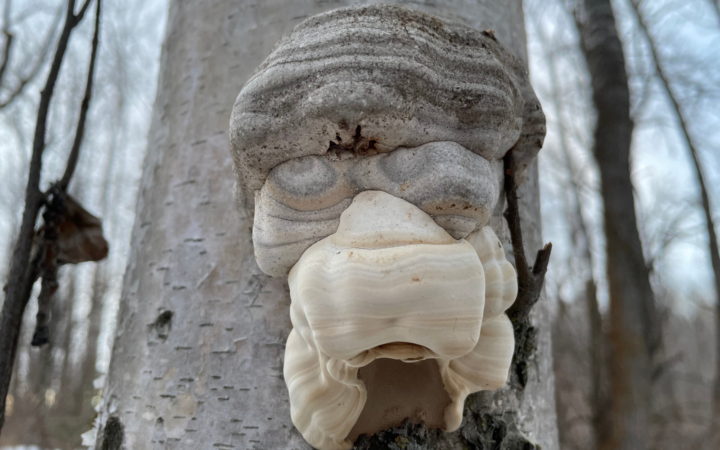Why Fomes Fomentarius Isn’t Just A Boring Polypore
Fomes fomentarius. You can’t eat it. It’s not one of the “superstars” of the medicinal mushroom world.
But it’s far more than just another tree disease.
Its name—which means “tinder” (Fomes) and “used for tinder” (fomentarius)[1]—reflects its practical uses, and some emerging research suggests the mushroom may also have healing properties*.
Could this unassuming fungus be hiding superpowers?
Maybe Otzi the Iceman, who had some Fomes fomentarius in his possession when his remains were discovered, could have offered some clues. Since he’s not talking, it’s up to nature and science to give the answers!
Fomes Fomentarius Description and Life Cycle
Also called tinder fungus, hoof fungus, tinder conk, tinder polypore and (appropriately) ice man fungus, Fomes fomentarius infects hardwood trees by infiltrating broken bark. The fungus feeds off the wood as it grows and causes white rot, which spreads until the wood becomes soft and spongy and eventually kills the tree.[2]
As a bracket fungus and a polypore, this mushroom shares some physical characteristics with reishi mushrooms. It grows in a fanlike shape and releases its yellowy spores from pores on the underside of the fruiting body instead of gills. Its color can range from silver-gray to black with a brownish hue underneath. The older the mushroom gets, the darker it becomes.[3]
Fomes fomentarius also changes shape as it grows. Most of the fruiting body’s diameter develops in the first three to four years; from there, the fungus continues to add layers, creating a “hoof” shape with visible concentric ridges. These fruiting bodies can survive for up to 30 years and grow anywhere from 10 cm to 40 cm (3.9 to 15.7 inches) across and up to 20 cm (7.8 inches) deep.

Where to Find Fomes Fomentarius in the Wild
Tinder fungi aren’t terribly social mushrooms, though—specimens tend to grow alone rather than in groups. They prefer warmer temperatures in the range of 27 C to 30 C (81 F to 86 F) and can be found hanging out in:
- Asia and Europe
- Eastern North America
- Northern and southern Africa
Fomes fomentarius typically infects birch and beech trees but can also grow on oak, maple, cherry hickory, popular, willow, alder, sycamore and other hardwoods.[4]
The distinctive shape and growth pattern mean this mushroom doesn’t have many lookalikes. Willow bracket is sometimes called “false tinder fungus,” perhaps due to sharing a similar shape. Birch polypore and artist’s conk are also hoof- and bracket-shaped polypores but have characteristics that set them apart from the true tinder polypore.
Tinder Fungus History (It’s ancient!)
Since Otzi was carrying some Fomes fomentarius around with him, it’s pretty clear people have been using the polypore for several thousand years. But it wasn’t described scientifically until 1753 when Swedish botanist Carl Linnaeus included it in Species Plantarum, a massive book that first established the practice of assigning both a genus and species names to plants.[5]
The mushroom started out as Boletus fomentarius and was eventually placed in the Fomes genus when Elias Magnus Fries, another Swedish botanist (and mycologist!) classified it as such in 1849.
In between the time of Otzi and these two scientists from Sweden, this unique bracket fungus was hailed by some as a remedy for a range of ills:
- Hippocrates cited Fomes fomentarius for its ability to staunch bleeding*
- Practitioners of traditional Chinese medicine believed it could treat throat, stomach and uterine cancer*[6]
- Indian medicine used it as a diuretic, laxative and “nerve steadying” tonic*
- European cultures applied it to cases of dysmenorrhea, hemorrhoids and bladder disorders*[7]
However, tinder fungus hasn’t yet made its way into the company of other medicinal mushrooms currently gaining popularity in the Western world. The best way to know if this laundry list of folk remedies could have practical applications in modern medicine is to look at the science.
Does Fomes Fomentarius Really Have Medicinal Properties?
There isn’t yet a lot of evidence for the tinder polypore’s effectiveness as an antidote for specific ills, but researchers are beginning to take an interest in uncovering its secrets.
Like the more commonly known medicinal mushrooms, Fomes fomentarius contains both polysaccharides and terpenes.[8] These compounds have been found to exhibit interesting—and sometimes powerful—properties when extracted from other species and put to the test in lab settings*.
But what about this species?
Here’s a little of what this tree fungus may be able to do:
- Combat inflammation by inhibiting production of pro-inflammatory compounds*[9]
- Reduce pain by bringing down levels PGE2 and COX-2, which are associated with inflammation*[10]
- Act as an antimicrobial against bacteria and viruses*[13,14,15]
- Provide a potential therapy for diabetes via a compound called fomentariol*[16]
- Act as an antioxidant to prevent cell damage*[17]
Additional therapeutic potential lies in the way Fomes fomentarius apparently affects the immune system.
In one study, scientists gave mice varying doses of polysaccharide extracts from the mushroom to test its interactions with immune cells. They found evidence of enhanced immunity even at the lowest doses, including more white blood cell activity and a greater capacity to destroy pathogens*.[18]
Other Uses for Tinder Fungus
With all these interesting properties, it’s natural to wonder if Fomes fomentarius is edible. However, there’s a reason you mostly see the tinder fungus described as functional or medicinal and not a centerpiece for recipes.
Although it’s not known to be toxic,[19] this particular mushroom isn’t a tasty delicacy, either.
It’s a challenge to slice, and despite its fruity smell, the taste has been described as extremely unpleasant.[20] Better to stick with tastier culinary mushrooms, like the familiar button mushroom or the slightly more exotic lion’s mane!
Fomes fomentarius is, however, good for starting fires. Many people think that’s why Otzi the Iceman was carrying it around: to use it as an actual tinder fungus.
Following his example requires a sharp knife and a little patience. Slicing a section off the fruiting body reveals a softer inner material, which can then be “fluffed up” and set ablaze with flint or a match. Add some small, dry kindling, and ta-da! The beginnings of a campfire.
Much Ado about Amadou
And then—there’s amadou.
Ama-who?
Amadou is a spongy material made by soaking or cooking Fomes fomentarius in potassium nitrate or sodium carbonate before stretching out the fibers and drying them in sheets. (There’s even a vegan leather company called Amadou Fibers!)
The finished material is commonly used to make bags, hats and a small tool for drying off fly fishing lures.[21] It was also favored by dentists in years past to control bleeding and dry teeth during dental procedures*.
Should You Try Fomes Fomentarius?
Although extracts of the tinder fungus are available—and some people even make tea out of the fruiting bodies—there really isn’t enough research to confirm the potential benefits of this mushroom. There’s also no information on safety, toxicity or interactions.
You can, however, forage for this mushroom and carry it around to use as tinder on your next hike or camping trip. Just be careful not to take too much. Fomes fomentarius takes a long time to grow and is starting to become less common in some areas due to overharvesting.
As interest in medicinal mushrooms begins to grow, science may uncover more unique properties of the tinder fungus beyond its interesting growth pattern and handiness as a fire starter. Perhaps one day, it will join mushrooms like reishi and chaga as a powerhouse of medicinal potential!


